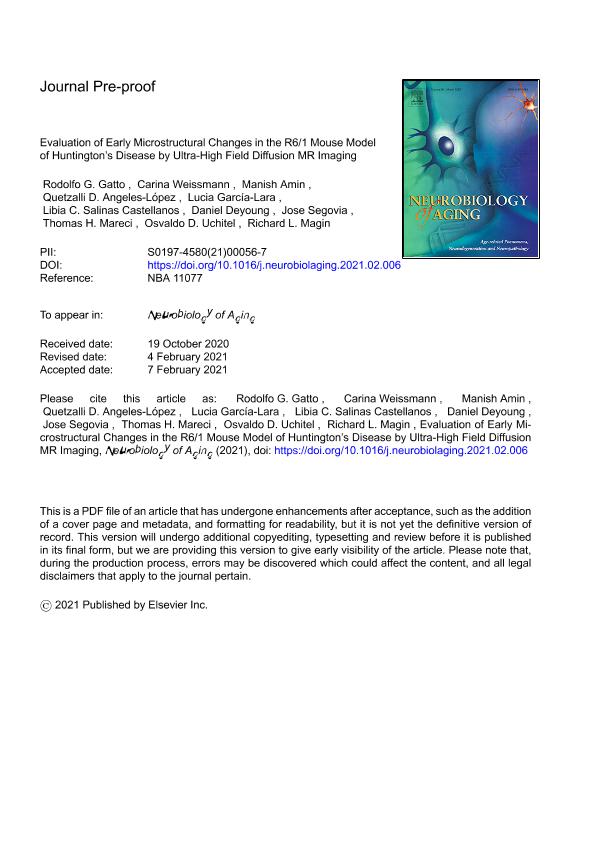Artículo
Evaluation of Early Microstructural Changes in the R6/1 Mouse Model of Huntington's Disease by Ultra-High Field Diffusion MR Imaging
Segatto, Rodolfo Guillermo; Weissmann, Carina ; Amin, Manish; Angeles López, Quetzalli D.; García Lara, Lucia; Salinas Castellanos, Libia Catalina; Deyoung, Daniel; Segovia, Jose Manuel; Mareci, Thomas H.; Uchitel, Osvaldo Daniel
; Amin, Manish; Angeles López, Quetzalli D.; García Lara, Lucia; Salinas Castellanos, Libia Catalina; Deyoung, Daniel; Segovia, Jose Manuel; Mareci, Thomas H.; Uchitel, Osvaldo Daniel ; Magin, Richard L.
; Magin, Richard L.
 ; Amin, Manish; Angeles López, Quetzalli D.; García Lara, Lucia; Salinas Castellanos, Libia Catalina; Deyoung, Daniel; Segovia, Jose Manuel; Mareci, Thomas H.; Uchitel, Osvaldo Daniel
; Amin, Manish; Angeles López, Quetzalli D.; García Lara, Lucia; Salinas Castellanos, Libia Catalina; Deyoung, Daniel; Segovia, Jose Manuel; Mareci, Thomas H.; Uchitel, Osvaldo Daniel ; Magin, Richard L.
; Magin, Richard L.
Fecha de publicación:
06/2021
Editorial:
Elsevier Science Inc.
Revista:
Neurobiology of Aging
ISSN:
0197-4580
Idioma:
Inglés
Tipo de recurso:
Artículo publicado
Clasificación temática:
Resumen
Diffusion MRI (dMRI) has been able to detect early structural changes related to neurological symptoms present in Huntington's disease (HD). However, there is still a knowledge gap to interpret the biological significance at early neuropathological stages. The purpose of this study is two-fold: (i) establish if the combination of Ultra-High Field Diffusion MRI (UHFD-MRI) techniques can add a more comprehensive analysis of the early microstructural changes observed in HD, and (ii) evaluate if early changes in dMRI microstructural parameters can be linked to cellular biomarkers of neuroinflammation. Ultra-high field magnet (16.7T), diffusion tensor imaging (DTI), and neurite orientation dispersion and density imaging (NODDI) techniques were applied to fixed ex-vivo brains of a preclinical model of HD (R6/1 mice). Fractional anisotropy (FA) was decreased in deep and superficial grey matter (GM) as well as white matter (WM) brain regions with well-known early HD microstructure and connectivity pathology. NODDI parameters associated with the intracellular and extracellular compartment, such as intracellular ventricular fraction (ICVF), orientation dispersion index (ODI), and isotropic volume fractions (IsoVF) were altered in R6/1 mice GM. Further, histological studies in these areas showed that glia cell markers associated with neuroinflammation (GFAP & Iba1) were consistent with the dMRI findings. dMRI can be used to extract non-invasive information of neuropathological events present in the early stages of HD. The combination of multiple imaging techniques represents a better approach to understand the neuropathological process allowing the early diagnosis and neuromonitoring of patients affected by HD.
Archivos asociados
Licencia
Identificadores
Colecciones
Articulos(IFIBYNE)
Articulos de INST.DE FISIOL., BIOL.MOLECULAR Y NEUROCIENCIAS
Articulos de INST.DE FISIOL., BIOL.MOLECULAR Y NEUROCIENCIAS
Citación
Segatto, Rodolfo Guillermo; Weissmann, Carina; Amin, Manish; Angeles López, Quetzalli D.; García Lara, Lucia; et al.; Evaluation of Early Microstructural Changes in the R6/1 Mouse Model of Huntington's Disease by Ultra-High Field Diffusion MR Imaging; Elsevier Science Inc.; Neurobiology of Aging; 102; 6-2021; 32-49
Compartir
Altmétricas



